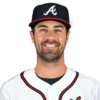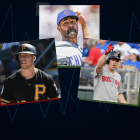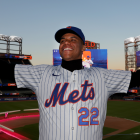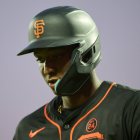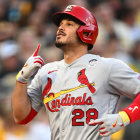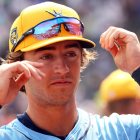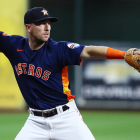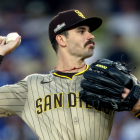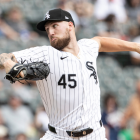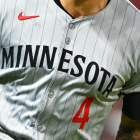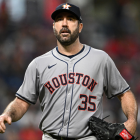T-minus four weeks and six days until the July 31 trade deadline. It is a single July 31 trade deadline now, so there's no chance to add help -- or unload veterans -- on trade waivers in August. All those teams on the postseason bubble have only a few more weeks to decide whether to cash their impending free agents in as trade chips, or hold on to them for a postseason push.
Until then, we're going to continue to keep tabs on the upcoming free-agent class. Here are our 2019-20 MLB Free Agent Power Rankings for June. July's edition will be released next week. For now, here are two impending free agents whose stock is on the rise, and two others who are trending down.
Stock Up
At some point we're going to need to have a conversation about whether Cole Hamels is a Hall of Famer. Right now, let's focus on his impending free agency. Hamels is having a marvelous season with the Cubs, with park-adjusted run prevention numbers that are more than 50 percent better than average.
As usual, the strikeouts are there for Hamels, but what stands out this year is his ability to keep the ball in the ballpark. Despite the launch angle craze and the (possibly) juiced baseball, Hamels has allowed one home run every 11 innings in 2019. From 2016-18, it was one homer every 7 2/3 innings. It's a significant difference.
Not surprisingly, Hamels is doing a better job keeping the ball on the ground this year. His 51.5 percent ground ball rate is comfortably above his 45.0 percent career average. Usually an increase in ground ball rate comes with a change in pitch selection, but no, Hamels is still a fastball/changeup guy, with a few cutters and curveballs mixed in to keep hitters honest.
What is different, however, is where Hamels is locating his four-seam fastball. He's keeping it down this year. Here are three heat maps showing where Hamels has located his four-seamer the last three years. In a nutshell, the darker the red, the more pitches in that location.
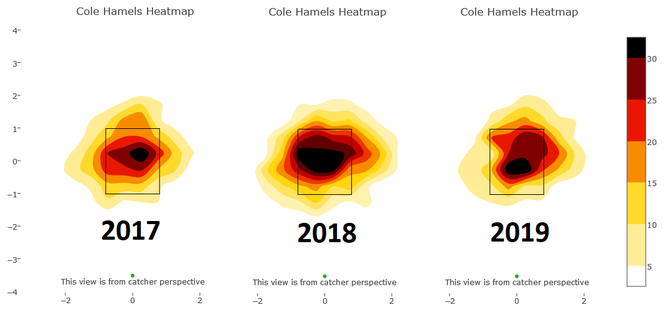
There is a higher concentration of fastballs in the bottom half of the strike zone this year. Keep the ball down and you'll keep the ball on the ground. Hamels has done that this year, and the result is fewer home runs. Add in his all-world changeup and veteran savvy and you have the makings of an uncomfortable at-bat, even with a fastball that mostly sits 90-91 mph these days.
I am inclined to believe Hamels will see his home run rate increase a bit as the weather warms up, which would be perfectly normal. Hamels does such a good job limiting baserunners overall that most of the extra homers figure to be solo shots, and you can live with solo homers. Especially with the Cubs offense backing you.
Even if the newfound ability to limit homers is a mirage, Hamels has been so good and so durable for so long that he will be very in demand as a free agent. His age (36 in December) will limit his earning potential, and in a way that makes him even more attractive. A high-quality starter on a short-term contract? Every contender will want in on that. Every single one.
J.A. Happ signed a two-year, $34 million contract with a $17 million vesting option at age 36 this past winter. Barring an injury or a total collapse in performance, that is the absolute floor for Hamels. Even in this free-agent climate, Hamels should be able to command two guaranteed years at $20 million apiece, with some sort of option/buyout that tacks on another few million.
A durable, low maintenance, impact veteran starter who's shown he can thrive in the postseason and thrive in large markets is about as desirable as it gets on a short-term contract. Hamels grew up in San Diego and I can't help but think signing with his up-and-coming hometown Padres is a perfect fit. That's something to worry about after the season though.
In a weird way, the addition of the 26th roster spot next season could hurt someone like Brock Holt. His value is in his versatility -- Holt has played six positions this year -- and, with the added roster spot next year, teams don't necessarily need that one guy who can play all over. They can carry a backup infielder and a backup outfielder. They don't need someone who can do both.
That all said, the bet here is Holt's pesky at-bats and on-base ability, as well as his aforementioned versatility, will land him a nice contract with a contending team after the season. He's shown he can thrive in a true backup role -- it's not easy to stay sharp when you rarely play -- and also contribute on an everyday basis when pushed into action. That's valuable.
Holt turned only 31 earlier this month, so while he probably doesn't have many peak years remaining, he's not so old that falling off a cliff is a significant concern. The Eduardo Escobar contract (three years and $21 million) might be a little rich. I could see Holt fetching multiple years at $5 million or so a pop though. Contenders obsessed with depth and versatility will be all over him.
Stock Down
For all intents and purposes, Pirates outfielder Corey Dickerson has been Wally Pipped. Shoulder trouble sent Dickerson to the injured list seven days into the season and, when he returned earlier this month, rookie Bryan Reynolds (.362/.418/.564) and veteran Melky Cabrera (.308/.342/.431) were playing way too well to take out of the lineup.
As a result, Dickerson has started only nine of the team's 16 games since returning from the injured list. He has gone 15 for 38 (.395) with eight doubles in those nine games plus five pinch-hitting appearances, including a double on a pitch that bounced Wednesday night ...
... so that's good, but it's hard to raise your free agent stock when you're a part-time player. Dickerson is only 30 and he surely wants to market himself as an everyday player. He'll need to wrestle some at-bats away from Reynolds or (more likely) Melky.
The good news? Chances are the Pirates will trade Dickerson at the trade deadline. They're unlikely to sign him long-term and they definitely won't make him the qualifying offer, so a trade it is (hello Indians). Dickerson could benefit from a change of scenery and an increased role with a contender. Getting traded stinks, but, in this case, it would be a positive for the player.
It was only a year ago that Dickerson hit .300/.330/.474 with 35 doubles and sneaky good defense, plus he doesn't strike out excessively in an era of high strikeouts. He could be a sneaky great value buy for some team after the season. For Dickerson, he really needs more playing time to maximize his earning potential. Being a part-timer will cost him.
I can't say I expected Yan Gomes to repeat his 2018 All-Star effort in 2019, but goodness, I didn't expect this sort of collapse either. Gomes is hitting .216/.298/.315 in his first season with the Nationals and his defensive numbers, always his calling card, are in the tank as well. From Baseball Prospectus:
- 2017: 6.8 fielding runs above average in 856 innings
- 2018: 9.1 fielding runs above average in 948 2/3 innings
- 2019: 1.1 fielding runs below average in 389 innings
As a result of his all-around poor play, Gomes has lost playing time to veteran stalwart Kurt Suzuki these last few weeks -- Gomes has started only six of Washington's last 14 games -- and with the Nationals getting back into the postseason race, I have to think manager Dave Martinez will stick with his best players. Behind the plate, that's Suzuki, not Gomes.
Gomes is in the final guaranteed season of the six-year, $23 million contract he signed with the Indians back in the day. The contract includes a $9 million club option ($1 million buyout) for next season, and coming into the season, picking up the option seemed like a no-brainer. Quality catchers are hard to find and Gomes is a solid two-way guy. Now, I'm not so sure.
The bet here is, even if the Nationals decide to move on, they would pick up the option and look to trade Gomes rather than simply decline the option. You needn't look back too far to see the last time he was a quality contributor, plus his contract includes an $11 million option for 2020, so there's added control. I think some team would give up a prospect to get him.
Given the way things are going right now though, that $9 million option for next season has suddenly become a tough decision for the Nationals. Gomes isn't working out as expected, and with the team needing every available dollar to lock up Anthony Rendon, the catcher could be a roster casualty. Declining the option may not be likely, but it is now in play.


